It is unnecessary to stress the centrality of the artifact within the field of archaeology. The recovery and analysis of “things,” “materials,” “objects,” and even “stuff” is the very foundation for how we interpret and understand all aspects (social, economic, political, etc.) of human life and culture. Despite the primacy of “things” in archaeology, and our acute dependence upon them to achieve our research goals, as archaeologists we have to some extent failed to recognize the full significance of artifacts. Gosden and Marshall recognize that we tend to view objects as “vital to social processes but seldom as informing it” (1999: 169). However, as the 1996 publication of the first issue of the Journal of Material Culture indicates, in the last two decades archaeological and anthropological methodology has finally begun incorporate more theoretical approaches to materials and materiality. One such approach is to use the metaphor of the biography. By discussing the “life history” of a thing we can go beyond a mere chaîne-opératoire description of the use-life of an object, in which the thing is regarded as “a passive, inert material to which things happen and things are done” (Gosden and Marshall 1999: 169). While use-life analyses are certainly important in that they acknowledge the dynamic nature of an artifact, they still fail to take into account the potential agency of an object. In this paper I want to explore the idea that a thing can also be an actor, one that actively contributes to the creation and alteration of meaning through its social interaction with people and other things over time and through space.
As Heidegger (1927), Harmon (2002) and other thinkers have noted, because “things” are so ubiquitous and commonplace in our everyday lives and world they are often—in effect—invisible to our perception. It’s easy to literally take things for granted, and thus it is sometimes very difficult to reflect about how an ordinary object might actively construct meaning through our interaction with it (and vice versa). Because of this potential limitation, I find it is easier to consider something that I regard as being rather special, a particular thing of which I have continuously been aware since it came into my life. This object is one of two identical cloths (Figures 1) that I purchased in 2005 while shopping in the suq of Aswan in southern Egypt. It is a rectangular piece of fabric, measuring roughly 5’x7’; it is thin, finely woven, stiff, and tan in color; with a pattern of lotus flowers, arabesques, and a central medallion painted in bright red, indigo, teal, yellow and pink colors. A small tag attached to one corner says that the material is 100% cotton and was made in Egypt.
 Figure 1 (above)
Figure 1 (above)
I could begin my commentary with the “birth” of the cloth, i.e. discussing the various aspects of its production, such as what raw materials were used, who made it and where (local villagers or factory workers?), and how it was made (mass produced or hand woven and painted?). However, I would like to avoid the typical chaîne-opératoire description if possible, and I also think it is more appropriate to begin this story with when I myself first interacted with the cloth. Cloth is of course not a new material for me, but the particular design and use of Egyptian cloth was indeed new to my ken in 2005. My first exposure to such large and colorful pieces of fabric was while I was on a jeep safari with three friends in the Western Desert. Our Egyptian guides, Mohammad and Mahmoud, erected camp against one side of our jeep using large panels of fabric to guard against the wind and to create a sort of half-tent nestled in the sand (Figure 2).
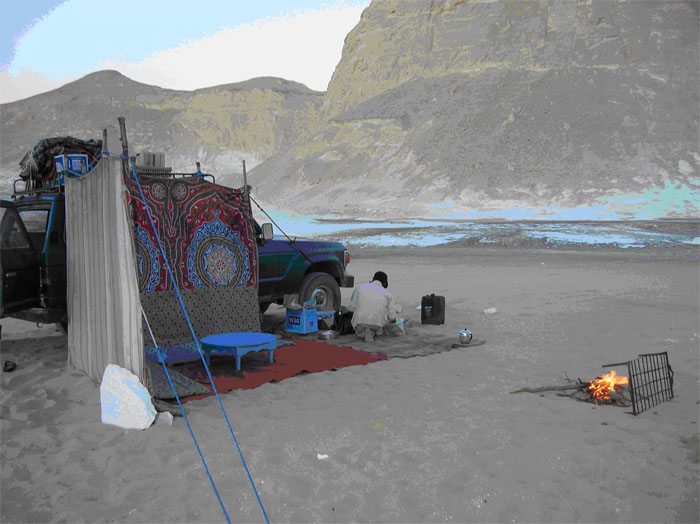 Figure 2 (above)
Figure 2 (above)
I remember lying in my thin sleeping bag and looking up at the stars, alternately contemplating the universe and the remoteness of where I was lying, thinking about how cold the desert could be at night, and being incredibly grateful and impressed by such a simple yet effective barrier against the night breeze. I couldn’t help but wonder at the versatility of a piece of fabric! No fancy tents were needed and I saw how easy it could be to make a comfortable, beautiful, and minimalist shelter. This was the beginning of my contemplations of the material culture of the local people: what “necessities” (to our Western mind) they did without and how the things at hand enable them to adapt to their local economic and environmental conditions—the simplicity and effectiveness of this lifestyle (which was created not only by the people themselves but by the things themselves) impressed and stayed with me long after I left the desert.
The second time I contemplated a brightly painted Egyptian cotton cloth was while I was taking in the sites and sounds as a tourist in Aswan. After a long day of visiting temples I treated myself to a libation on the porch of the famous (and exclusively European) Old Cataract hotel, and enjoyed sitting in the wicker chairs while taking in the setting. I was made keenly aware of my surroundings: the cool and comfortable space of the porch as a refuge from the hot sun, the turn-of-the-20th-century Oriental décor of the hotel, the “traditional dress” (uniforms) of the Egyptian staff contrasted against the garb of the wealthy European tourists, and the exotic flora of the manicured grounds. My eyes were drawn to the large painted fabric hangings suspended around the upper portions of the porch (Figure 3), which served to shade the loungers from the glare of the sun and to add to the timeless Oriental elegance of the setting with its swirls of color. Again, the usefulness and beauty of a simple piece of material caught and held my attention, and I made an effort to tuck away the particular patterns and colors to use as a prompt for future reminiscences.
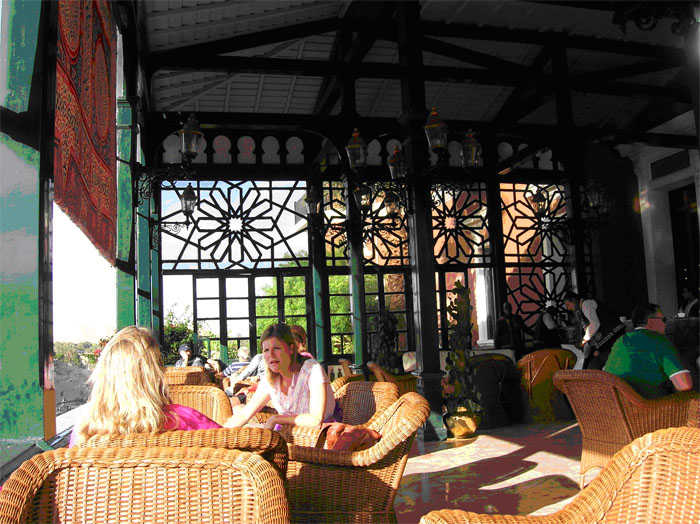 Figure 3 (above)
Figure 3 (above)
One day later, as I was wandering through the suq of Aswan and buying souvenirs for myself, I found myself face to face with the same brightly colored fabric as the hangings of the Old Cataract Hotel for sale in one of the merchants’ stalls. I felt a sudden need to own such a piece of fabric, to take a piece of the exotic 19-20th century Orientalist decadence back home with me, to be able to have a tangible link to the moment of my being in that place and time (which I worried would quickly become like a dream—a hazy and distant memory). I talked casually with the teenager who was working in the stall, trying to barter in the traditional manner (Figure 4) using as much Arabic as I could muster, but I had trouble: the kid wanted to sell me two cloths and I just couldn’t convince him I just wanted the one. “What do I need two for?” I continuously asked, and pointed out that I would pay him more for one than I would end up paying him for each of the two. But it was the end of the day for him, and I think he wanted to move some merchandise. I thought about doing the usual routine of making a big show of refusal and walking away (so that he could be call me back again and change the deal to my satisfaction), but I *really* wanted the cloth and didn’t want to risk not actually getting it; so in the end I did pay more and wound up with two cloths.
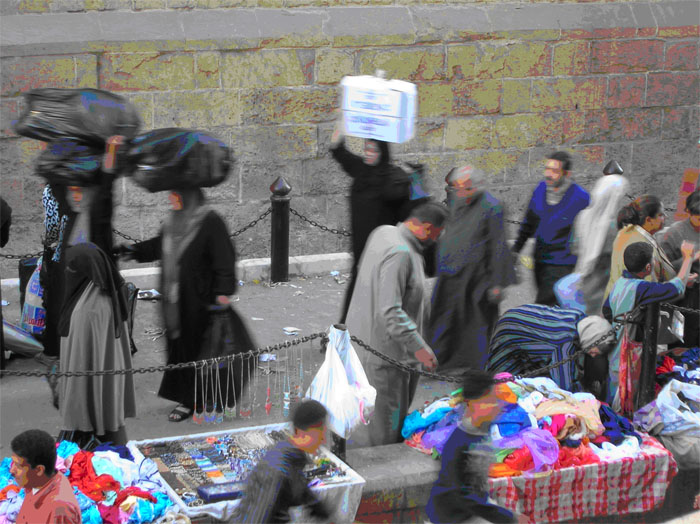 Figure 4 (above)
Figure 4 (above)
Once back in the United States I kept the cloths packed away with all my belongings for about nine months, until I moved to an apartment in Providence. Part of my process of moving in was to decorate my new place in a way that would both reflect the person I understand myself to be (an archaeologist, a lover of the exotic and beautiful, a traveler, an artist, etc.) and to have my memories on display all around me. I laid out the cloth, cut it into three panels—one large square panel of the central medallion and two longer panels of the flanking decoration (Figures 5 and 6)—and stapled it to the sort of wooden stretchers that artists use to make their own canvases. I hung these up on the wall of my bedroom, and the result was stunning: my room has minimal furnishings and decorations (dark wood furniture, white walls and ceiling, cream linens) and the three beautifully colored wall hangings capture the eye and inspire meditation and reflection.
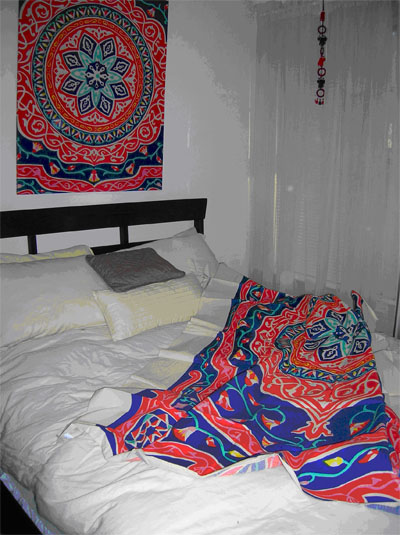 Figure 5 (above)
Figure 5 (above)
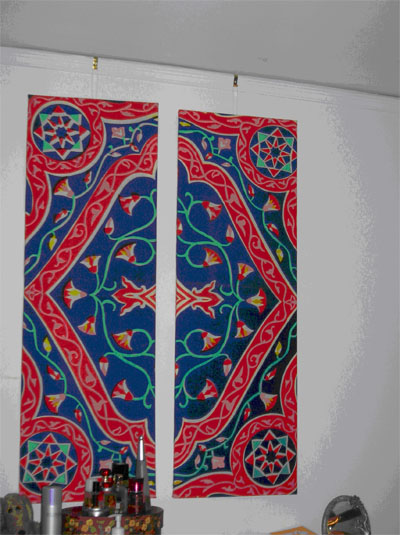 Figure 6 (above)
Figure 6 (above)
I think it is fascinating that the photos that I have included here were originally taken without any intention of having cloth be the focus of the shot. However, by looking through this series of photos—snapshots of time and place—you can observe the subtle actions of the cloth within the scene and think about how it could affect the relationships and interactions between people and people, things and people, as well as between things and things. You can literally see what the cloth “was” in differing scenarios: a protective architectural feature, proof of the wealth and separation prevalent in the colonial “Oriental Gold Age,” a form of currency, and a work of art. Thinking about these various roles, I would argue that the cloth was not only vital to the social processes in which it was involved, it was also vital in informing those processes: for example, I actually might not have gotten economically involved with that Egyptian merchant in the suq if I had not first noticed the cloth at the Old Cataract Hotel, and I certainly would have walked away without buying anything if that specific cloth had not been one of the participants in our exchange.
This short writing piece is both personal and ethnographic. A first person narrative is not necessarily out of place here, as the material in question is my personal property and its history is deeply entangled with my own; the circumstances of how I became involved with the cloth is inextricably linked to my experiences in and impressions of Egypt (or my interactions with and thoughts about the people I encountered there, Egyptian and tourist alike). Studies of material culture emphasize that meanings accumulate and change, because “as people and objects gather time, movement, and change, they are constantly transformed, and these transformations of person and object are tied up with each other” (Gosden and Marshall 1999: 169); I think this is clearly the case in the social life of me and my material.
Works Cited:
Gosden, C. and Y. Marshall. 1999. “Cultural Biography of Objects.” World Archaeology 31, 169-178.
Heidegger, M. (1927) 1996. Being and Time. Albany: SUNY Press.
Harmon, G. 2002. Tool Being: Heidegger and the Metaphysics of Objects. Chicago: Open Court Publishing Company.
Journal of Material Culture 1996-2007.
For a Word file of my paper, click on:
 Social Life of a Thing.doc
Social Life of a Thing.doc
